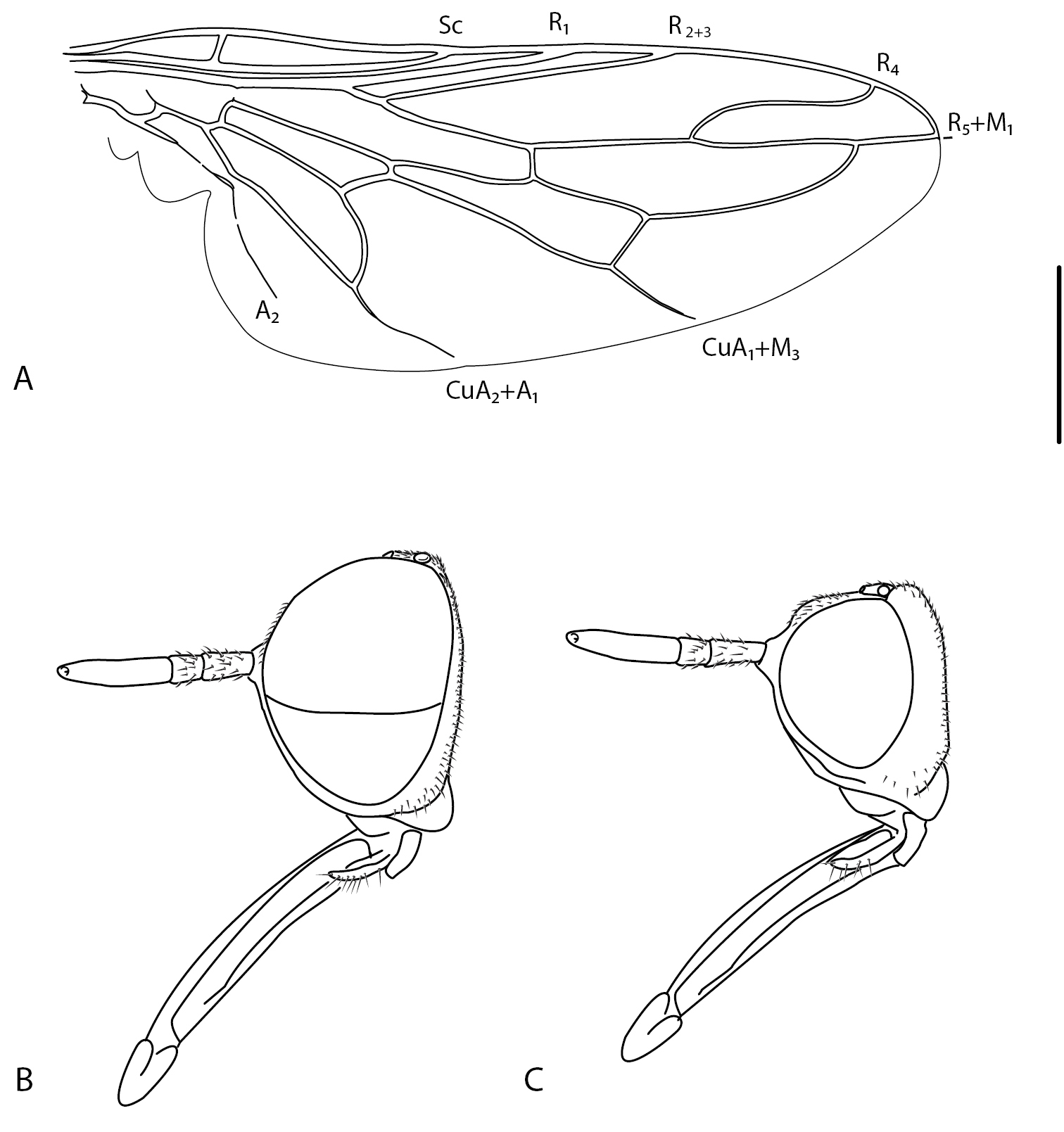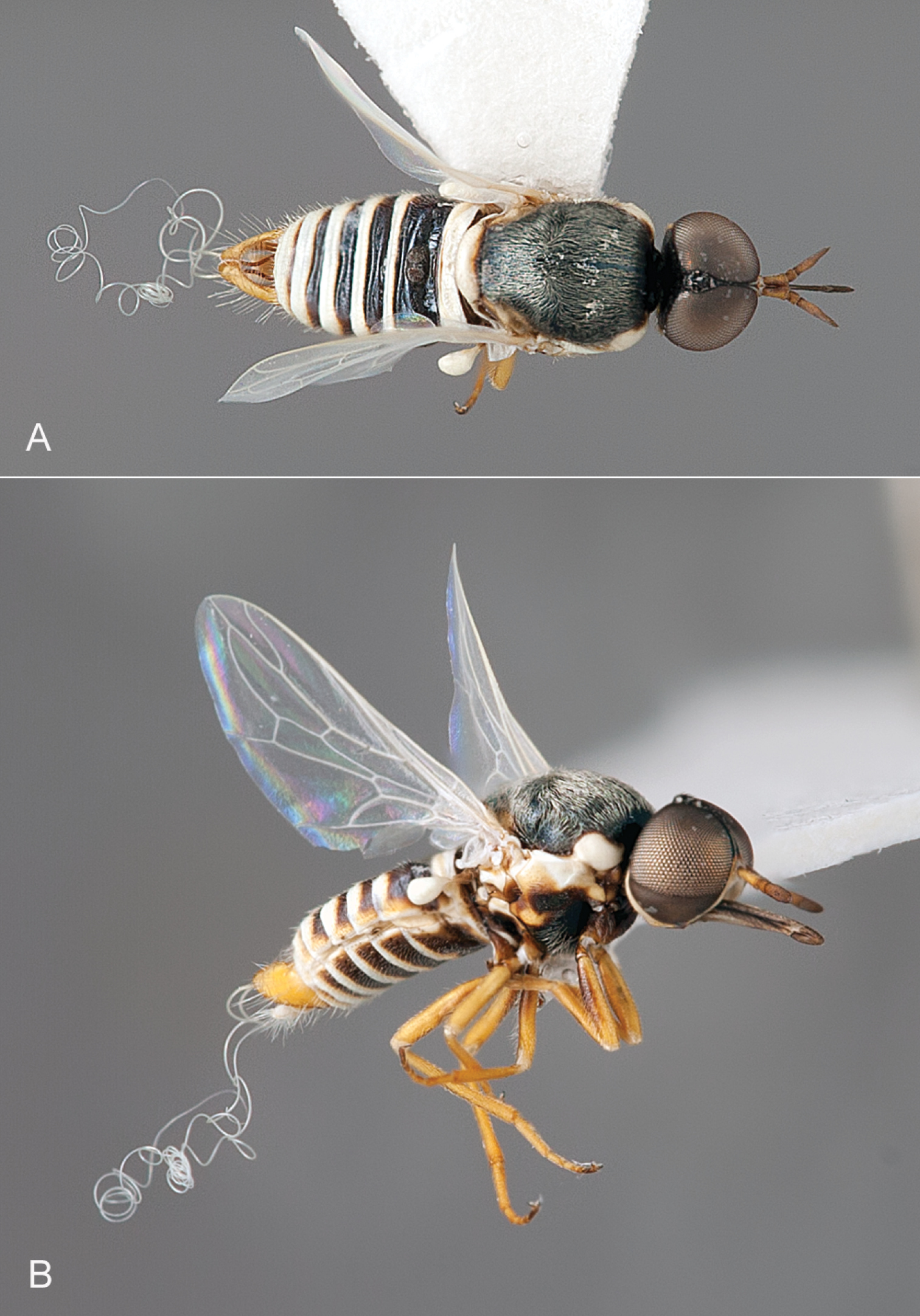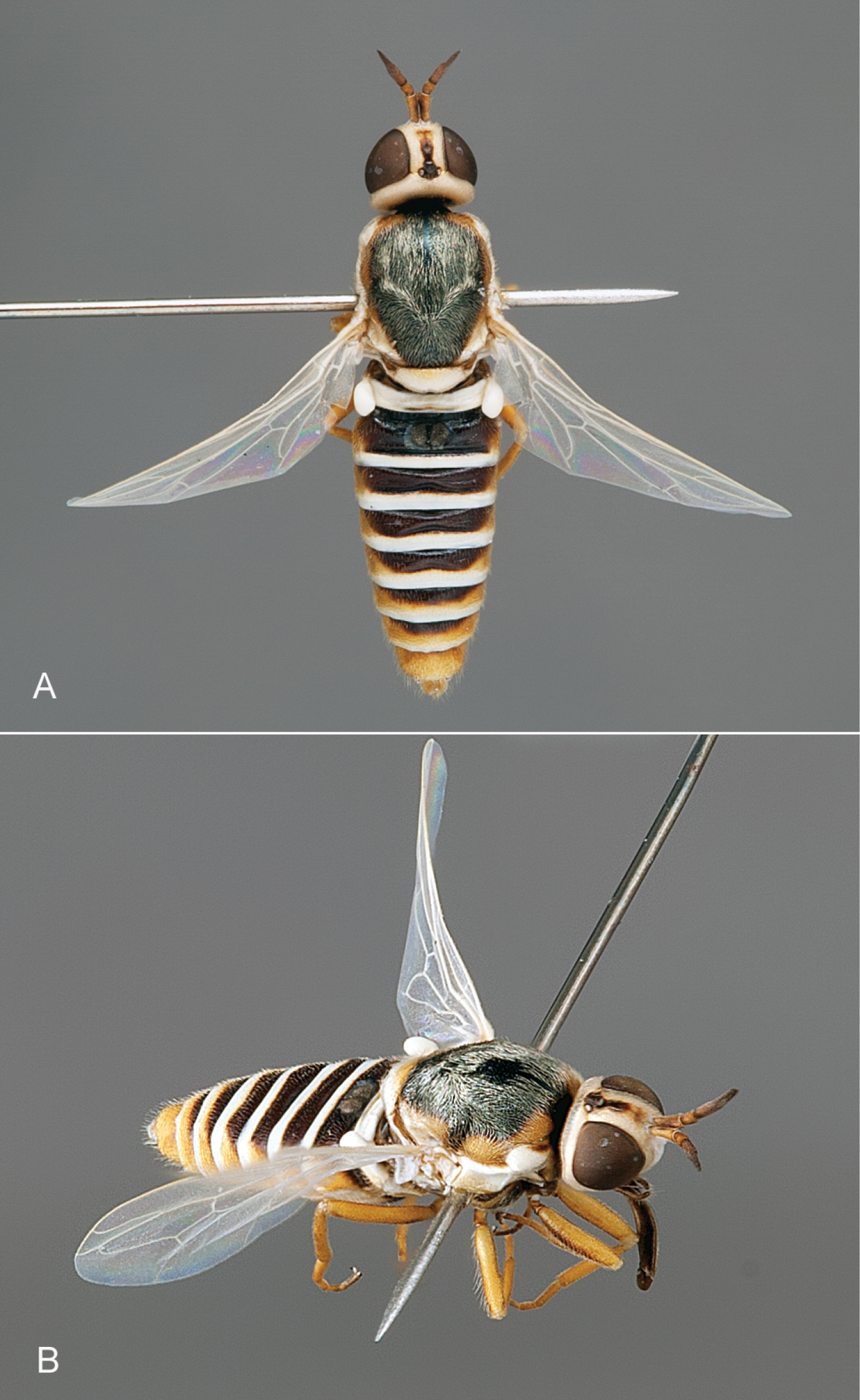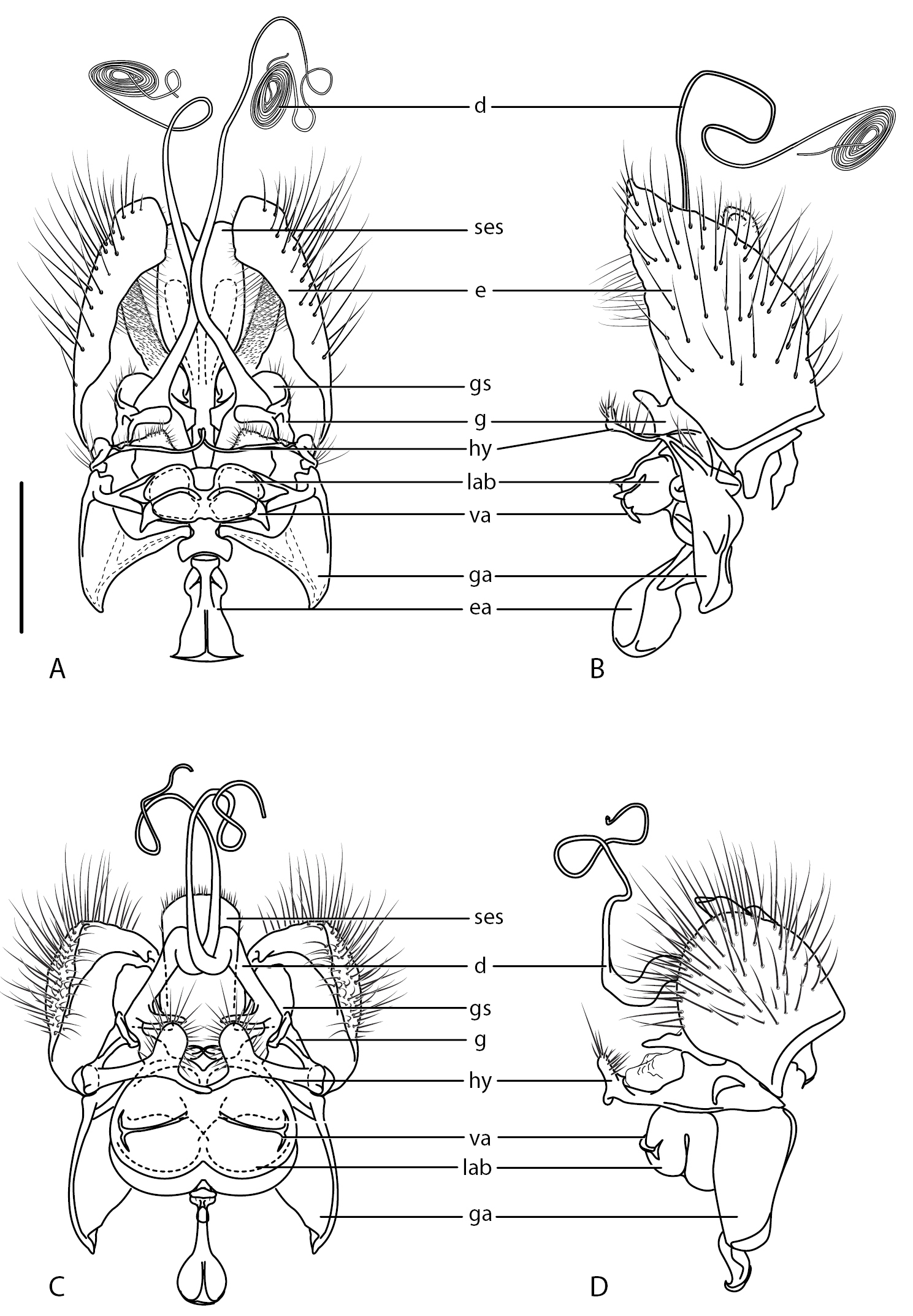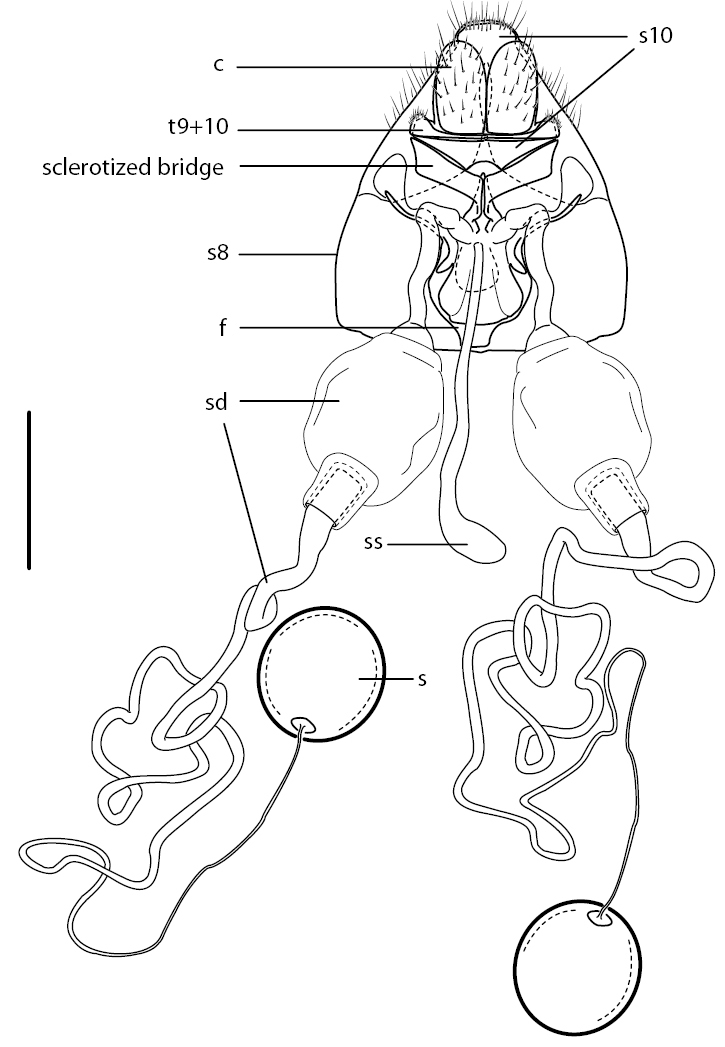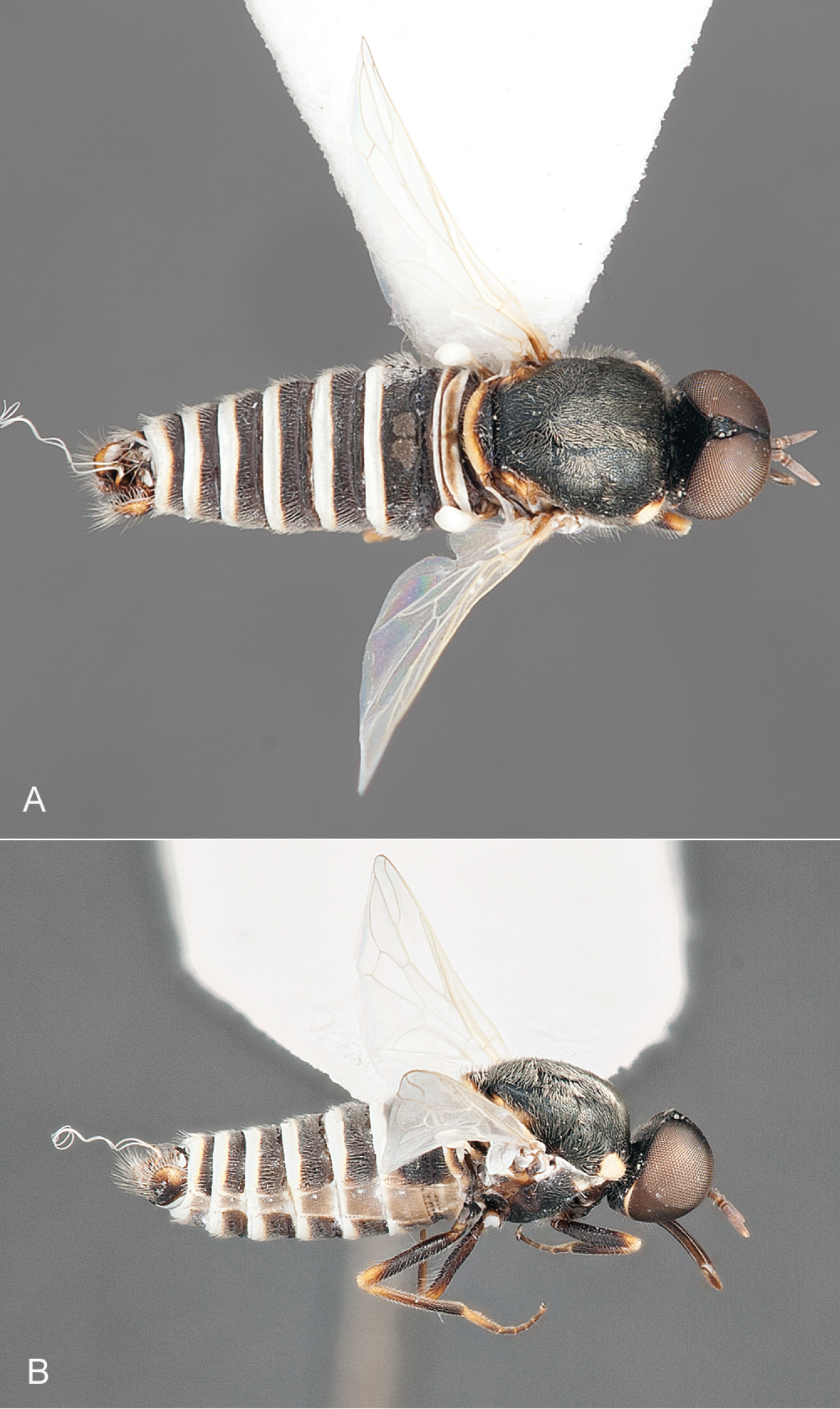






(C) 2011 Shaun L. Winterton. This is an open access article distributed under the terms of the Creative Commons Attribution License, which permits unrestricted use, distribution, and reproduction in any medium, provided the original author and source are credited.
For reference, use of the paginated PDF or printed version of this article is recommended.
An unusual new genus of Scenopinidae, Iranotrichia gen. n., comprising two newly discovered species (Iranotrichia insolita sp. n. and Iranotrichia nigra sp. n.), is described from Iran. Iranotrichia gen. n. are scenopinine window flies with a habitus reminiscent of certain bee fly genera (Bombyliidae), based on colouration and elongate mouthparts and antennae. The phylogenetic placement of this distinctive new genus is discussed and a dichotomous key to world genera is presented. The genus name Kelseyana nom. n. is proposed to replace Caenoneura Kröber, 1924, which was found to be preoccupied by
Therevoid clade, Asiloidea, Scenopinidae, key
Window flies (Diptera: Scenopinidae) are a small family (ca. 420 species in 26 genera) of flies with an adult body size rarely exceeding 5.0 mm. Scenopinids are distributed throughout all major biogeographical regions, and with few exceptions, most genera are confined to a single biogeographical region (Kelsey, 1973). This family is placed in the therevoid clade, comprising families such as Therevidae (stiletto flies), Apsilocephalidae and Evocoidae (Winterton, 2008;
Iranotrichia gen. n. is described herein from northern Iran, comprising two species, Iranotrichia insolita sp. n. and Iranotrichia nigra sp. n. This new genus is morphologically very similar to other scenopinine genera such as Metatrichia Coquillett, 1900, Kelseyana nom. n. (= Caenoneura Kröber, 1923) and Pseudomphrale Kröber, 1913. This group of genera is differentiated by other scenopinine genera based on the following characteristics: wing vein M1 fused to vein R5 before wing margin, mouthparts well developed, scutum with extensive pile (often scale-like), abdomen broad and flattened in both sexes with limited sexual dimorphism, male genitalia with gonocoxal apodemes relatively broad, and female acanthophorite spines absent. Metatrichia is a cosmopolitan genus containing 16 extant and one fossil species. (
Genitalia were macerated in 10% KOH at room temperature for one day to remove soft tissue, then rinsed in distilled water and dilute acetic acid, and dissected in 80% ethanol. Preparations were then placed into glycerine, with images made with the aid of a digital camera mounted on a stereomicroscope. Genitalia preparations were placed in glycerine in a genitalia vial mounted on the pin beneath the specimen. Terminology follows
Key to therevoid clade families and Scenopinidae genera of the world:
Note: Metatrichia and Pseudomphrale cannot be separated at this time and are included together in couplet 21.
| 1 | Wing with vein CuA1 arising from apex of cell bm; connected to discal cell by cross-vein m-cu; three medial veins present; male epandrium not medially divided | 2 |
| – | Wing with vein CuA1 integrated into at least part of posterior margin of discal cell; one or two (rarely three) medial veins present; male epandrium medially divided | 3 |
| 2 | Antennal style elongate and filamentous | Apsilocephalidae |
| – | Antennal style very short, often barely evident | Therevidae |
| 3 | Antennal flagellum comprised of bulbous base fused with a terminal filamentous style; vein CuA2 separate from A1 to wing margin | Evocoidae |
| – | Antennal flagellum shape variable, but never with an elongate terminal filament; vein CuA2 joining to A1, petiolate to wing margin | Scenopinidae: 4 |
| 4 | Wing with two veins originating posteriorly from discal cell (M1 and CuA1); male genitalia rotated 180° | Scenopininae: 11 |
| – | Wing with three (or rarely four) veins originating posteriorly from discal cell (M1, M2, M3 and CuA1); male genitalia not rotated | 5 |
| 5 | Costal vein extending around wing; sensory area on tergite 2 made up of two hemispherical regions of short setae; male genitalia with aedeagus and gonocoxal apodemes short (Nearctic) | Caenotinae: Caenotus Cole, 1923 |
| – | Costal vein ending at vein R5; male genitalia with aedeagus and gonocoxal apodemes greatly elongate | Proratinae: 6 |
| 6 | Abdominal tergite 2 setal patch absent; antennal flagellum abruptly turbinate with a tuft of apical setae; thickening of costal margin ending at or just beyond R4; abdomen largely white with brown terminalia (Nearctic) | Caenotoides Hall, 1972 |
| – | Abdominal tergite 2 setal patch present; antennal flagellum cylindrical or tapered, without tuft of apical setae; thickening of costal margin ending at or just beyond R5; abdomen typically uniform black, brown or pale yellow | 7 |
| 7 | Mouthparts elongate; antennal flagellum cylindrical; elongate setae along posterior margin of female abdominal tergite 8; male wing with M1 much shorter than M2; male gonocoxites with medial spine projecting posteriorly; gonocoxal apodemes and aedeagus barely projecting anteriorly from gonocoxites (Neotropical: Argentina) | Jackhallia Nagatomi & Liu, 1994 |
| – | Mouthparts length variable; antennal flagellum usually tapered, although sometimes cylindrical; setae along posterior margin of female abdominal tergite 8 short; male wing with M1 longer than or equal length of M2; male gonocoxites without medial spine; gonocoxal apodemes and aedeagus project anteriorly well beyond gonocoxites, sometimes greatly elongated | 8 |
| 8 | Abdominal tergite 2 setal patch rounded with very slight medial separation into two hemispheres; female tergite 8 with erect, elongate setae arranged in ring-like pattern; male aedeagus folded dorsally onto itself so that ejaculatory apodeme is projecting posteriorly (Afrotropical: Namibia) | Cyrtosathe Winterton & Metz, 2005 |
| – | Abdominal tergite 2 setal patch as a single rounded or elongate patch; female tergite 8 without erect, elongate setae; male aedeagus extending anteriorly and not folded on itself | 9 |
| 9 | Antennal flagellum gradually narrowed apically, with thick apical style that is wider than apex of preceding segment; anterior margin of female eye not emarginate (Nearctic) | Acaenotus Nagatomi & Yanagida, 1994 |
| – | Antennal flagellum only slightly tapered, with narrow apical, or more commonly subapical, style that is not wider than apex; anterior margin of female eye often triangularly emarginate just dorsal to base of antennae | 10 |
| 10 | Antennal flagellum with single segment (excluding apical style) (Palaearctic) | Alloxytropus Bezzi, 1925 |
| – | Antennal flagellum two segmented (excluding apical style), apical segment is minute and similar shaped to style in some species (e.g. Prorates frommeri Hall, 1972) (Nearctic) | Prorates Melander, 1906 |
| 11 | Wing vein M1 separate from vein R5 to wing margin (cell r5 open) | 12 |
| – | Wing vein M1 fused to vein R5 before wing margin (petiolate closed cell r5) | 16 |
| 12 | Wing vein M1 incomplete or terminating before wing margin | 13 |
| – | Wing vein M1 complete to wing margin | 14 |
| 13 | Male epandrium as two relatively short lobes; female with reduced spines on acanthophorite; female sternite 8 longer than tergite 8 (Australasian) | Riekiella Paramonov, 1955 (part) |
| – | Male epandrium as four elongate lobes; female acanthophorite spines elongate, slender; female tergite 8 and sternite 8 subequal (Australasian) | Paramonova Kelsey, 1970 (part) |
| 14 | Vein CuA1 terminating just beyond cell d; female sternite 8 with comb-like band of elongate setae (Afrotropical, Oriental) | Seguyia Kelsey, 1980 |
| – | Vein CuA1 reaching or terminating just prior to posterior wing margin; female sternite 8 without distinct comb-like band of elongate setae | 15 |
| 15 | Head length generally longer than height (sometimes subequal); body elongate; abdomen elongate and cylindrical; reared from wood-boring beetle galleries (Afrotropical, Palaearctic, Oriental) | Prepseudatrichia Kelsey, 1969 |
| – | Head length generally shorter than height; body relatively short; abdomen wide; reared from various habitats but not known from wood-boring beetle galleries (cosmopolitan) | Scenopinus Latreille , 1802 |
| 16 | Mouthparts atrophied (Nearctic) | BelostaHardy, 1944 |
| – | Mouthparts well developed | 17 |
| 17 | Head generally longer than high; body glossy black with verrucous surface microsculpturing, without extensive setal pile; abdomen greatly elongate and cylindrical along entire length; reared from wood-boring beetle galleries or vertebrate nests | 18 |
| – | Head generally shorter than high; body glossy black or frequently with extensive pubescence, surface microsculpturing absent, often with extensive setal pile; abdomen short and flat, sometimes greatly elongate and tapered in female, never cylindrical along entire length; not known from wood-boring beetle galleries | 19 |
| 18 | Male epandrium approximately as long as high (lateral view); posterior margin of sternite 6 unmodified, without processes; male gonostyli with comb-like band of elongate setae; female cerci without tuft of strong spines; apex of cell r5 blunt (Nearctic, Neotropical) | Pseudatrichia Osten Sacken, 1877 |
| – | Male epandrium distinctly shorter than high, band like (lateral view); truncated process along posterior margin of sternite 6; male gonostyli without elongate setae; female cerci with tuft of strong, ventrally directed spines; apex of cell r5acute (Australasian) | Neopseudatrichia Kelsey, 1969 |
| 19 | Relatively robust bodied flies with broad, flat abdomen in both sexes (frequently large sized); sexes approximately equal sized | 20 |
| – | Relatively delicate flies with narrow tapered abdomen (usually with relatively small body size), particularly in female; abdomen much longer in female, displaying distinct sexual size dimorphism | 22 |
| 20 | M1 and composite R5+M1 vein abruptly bent anteriorly to join wing margin subapically along costa (Palaearctic) | Kelseyana nom. n.(= Caenoneura Kröber, 1923) |
| – | M1 and composite R5+M1 vein not bent anteriorly (Fig. 1A), joining margin at wing apex | 21 |
| 21 | Antennae greatly elongate and cylindrical; flagellum broadly rounded to truncate apically but not notched, style subterminal (Figs 1B-C); mouthparts greatly elongate; male distiphallus greatly elongate and coiled (Figs 4A-D); body reminiscent of bee fly (Bombyliidae) (Palaearctic: Iran) | Iranotrichia gen. n. |
| – | Antennae not elongate; flagellum ovate to quadrangular, notched apically with style terminal in notch; mouthparts rarely elongate; male distiphallus short and straight, rarely protruding beyond genitalic capsule; body not resembling bee fly | Metatrichia Coquillett, 1900 (Cosmopolitan) and Pseudomphrale Kröber, 1913 (Palaearctic) |
| 22 | Glossy black flies without pubescence; antennal flagellum pointed, not notched; female cerci with tuft of strong ventrally projecting setae (Palaearctic) | Stenomphrale Kröber, 1937 |
| – | Body variously coloured with dense pubescence (rarely glossy black); antennal flagellum broad, notched apically; female cerci without tuft of strong setae | 23 |
| 23 | Wing with vein R4 branching from R5 along the basal half of cell r5; female acanthophorite spines well developed | 24 |
| – | Wing with vein R4 branching from R5 at halfway or along distal half of cell r5; female acanthophorite spines present, or reduced in size or shape, sometimes absent | 25 |
| 24 | Male distiphallus short and straight; male subepandrial sclerite not modified; female sternite 8 straight or slightly emarginate apically (Neotropical) | Heteromphrale Kröber, 1937 |
| – | Male distiphallus relatively long and thread-like, highly reflexed basally so that basiphallus and ejaculatory apodeme are projecting dorsally or posteriorly; subepandrial sclerite with anterior projecting, blade-like extensions serving as aedeagal guides; female sternite 8 with rounded posterolateral lobes (Nearctic, Neotropical) | Brevitrichia Hardy, 1944 |
| 25 | Female acanthophorite spines well developed (Afrotropical) | Propebrevitrichia Kelsey, 1969 |
| – | Female acanthophorite spines absent, or greatly reduced in length or thickness (Australasian, Neotropical) | 26 |
| 26 | Female sternite 8 apically trilobate; male epandrium unmodified, without posterior or medial processes (Neotropical) | Irwiniana Kelsey, 1971 |
| – | Female sternite 8 apically rounded or bilobate; male epandrium typically with multiple lobes and posterior or medial processes (Australasian) | 27 |
| 27 | Male epandrium with flange-like lobes internally | Paratrichia Kelsey, 1969 |
| – | Male epandrium without flange-like lobes internally | 28 |
| 28 | Male epandrium as two relatively short lobes; female sternite 8 longer than tergite 8, apically pointed | Riekiella Paramonov, 1955 (part) |
| – | Male epandrium as four elongate lobes; female sternite 8 length subequal to tergite 8 | Paramonova Kelsey, 1970 (part) |
urn:lsid:zoobank.org:pub:066C7733-FC95-4532-9465-8B123D0BEB33
Iranotrichia insolita sp. n.
Body length: 4.0–5.5 mm [male], 4.5–5.0 mm [female]. Head higher than long, sub-spherical, female with broad, raised postocular ridge; antenna elongate, cylindrical, length 0.6–1.2× head length; antennal style subterminal, flagellum broadly rounded to truncate apically, not notched; frons relatively flat, not protruding anteriorly; mouthparts greater than head length, projecting anteriorly; scutum with dense pile of semi-appressed, silver-white lanceolate setae, all directed towards a single posteromedial point (Figs 2–3, 6); wing vein M1 joining with R5 (Fig. 1A), cell r5 petiolate to wing margin; wing vein M2 absent; costal margin ending at vein R5; abdomen broad, width equal to thorax; tergite 2 sensory setae well defined and two circular patches. Male genitalia: rotated 180°; tergite 7 and sternite 7 broad and separate, not ring-like; male epandrium split medially as two sclerites, halves sub-circular or sub-triangular;epandrium not covering gonocoxites ventrally; hypandrium as, paired sclerites, narrow paddle-shape with short setae along posterior margin; gonostylus well developed, irregular shaped, dark sclerotized and irregular spinose marginally; aedeagus protruding anteriorly from epandrium only a relatively short distance; gonocoxite irregularly shaped and mostly reduced; gonocoxal apodeme relatively thickened, broadly triangular with medial braces joining with aedeagus; aedeagus with lateral aedeagal bulb present, sometimes well developed; distiphallus bifid, recurved dorsally at base then greatly elongate and coiled. Female genitalia: tergite 9+10 narrow and band-like, acanthophorite spines absent; sternite 8 slightly longer than tergite 8, broadly acuminate posteriorly; furca a dark-sclerotized ring with narrow posterolateral arm, connected posteromedially with ‘Y’-shaped sclerotized bridge between furca and anterior margins of tergite 9+10; two sclerotized spherical spermathecae; spermathecal sac simple, connected to bursa medially immediately anterior to spermathecal ducts.
The genus name is derived from the type location of members of this genus; Iran, -trichia (Greek: hair), referring to the setal pattern and has frequently been used historically to formulate to scenopinid generic names.
Included species. Iranotrichia insolita sp. n., Iranotrichia nigra sp. n.
This genus is placed in Scenopininae based on the rotated genitalia, wing venation and shape of the tergite two setal patches. The general habitus of members of this new genus is very reminiscent of certain genera of Bombyliidae. Iranotrichia gen. n. is morphologically very similar to Metatrichia and Pseudomphrale, but can be separated from these and other Scenopinidae based on the greatly elongate and often coiled bifid distiphallus, elongate antennae and mouthparts, flagellum not notched apically and with style subapical on outer surface. The elongate antennae and mouthparts and distiphallus are characteristic of Iranotrichia; although such elongation of these structures is sometimes found in proratine genera such as Prorates and Jackhallia, it is not found elsewhere in Scenopininae. Some species of Pseudomphrale and Metatrichia have elongated mouthparts (e.g. Metatrichia palaestinensis (Kröber, 1937), Metatrichia freidbergi Krivoshiena and Krivosheina, 1999, and Pseudomphrale longirostris Becker, 1913) (
| 1 | Head, thorax, abdomen and legs with extensive areas of yellow and white; terminalia yellow; distiphallus of male as long or longer than body when uncoiled | Iranotrichia insolita sp. n. |
| – | Head, thorax, abdomen and legs dark, with limited areas of yellow and white; terminalia dark; distiphallus of male less than length of body when uncoiled | Iranotrichia nigra sp. n. |
urn:lsid:zoobank.org:act:1567D17A-C21B-48F9-9029-F451F6A9A603
http://species-id.net/wiki/Iranotrichia_insolita
Figs 1–4A, B, 5Type material. Holotype male, IRAN: Ghazvin province: 17 km NE Ghazvin, Abazar village road, rangeland, 36.2916°, 50.1583°, white pan trap, 19.vi.2010, B. Gharali (NMNH). (excellent condition).
Paratypes. IRAN: 55 males, 9 females, Ghazvin province: 17 km NE Ghazvin, Abazar village road, rangeland, 36.2916°, 50.1583°, white pan trap, 19.vi.2010, B. Gharali (CSCA (3 males), CAS (10 males 2 females), NMNH (10 males, 2 females), IRIPP (10 males, 2 females), personal collection of BG (20 males, 3 females)).
Head, thorax, abdomen and legs with extensive areas of yellow and/or white; combined length of scape and pedicel equal to length of flagellum; scutellum white with yellow suffusion anteromedially; terminalia yellow; epandrium elongate and sub-triangular; distiphallus of male as long or longer than body when uncoiled; distiphallus arms without spinose process.
Body length:4.0–4.5 mm [male], 4.5–5.0 mm [female]. Head. Male frons glossy black, dark yellow around base of antennae; female frons white with broad dark brown stripe medially extending ventrally from ocellar tubercle, suffused near base of antennae; frons of both sexes with short setae, setae white near base of antennae; ocellar tubercle black, raised in male, flat in female; occiput glossy black (male) or white-yellow with black medially around occipital foramen (female); occiput with sparse, short yellowish setae; gena yellow, raised as ridge along eye margin, sparse short pale setae; parafacial white to yellow, oral cavity with dark yellow sclerotized plates either side of dark medial strip; mouthparts elongate, dark brown, labellum narrow, proboscis flattened laterally (in dried specimen); palpus dark brown, short; antenna slightly longer than head length, dark yellow basally, dark brown distally; short white setae on scape and pedicel; scape 2–3X pedicel length, combined scape and pedicel length equal to length of flagellum; flagellum truncated apically. Thorax. Scutum black, pale white to dark yellow areas marginally (i.e. postpronotal lobe and post-alar callus), more extensive in female and additionally with yellow on anterior part of scutum adjacent to postpronotum and medially on posterior part of scutum; scutal pile dense with three indistinct vittae anteriorly on prescutum formed by unidirectional parting of setae; scutellum matte white, yellow anteromedially, sparse pale setae covering marginally; pleuron black with white to dark yellow dorsally on anepisternum and katepisternum, and around base of wing (pale area more extensive in female); white setae on katepisternum; coxae black to brown; legs yellow, femora frequently with brown suffusion basally on posterior surface; short pile of white-yellow setae on legs, longer on posterior surface of femora; distal tarsomeres suffused with brown; haltere stem brownish, knob white; wing milky hyaline from sparse microtrichia; venation cream-white. Abdomen. Glossy black, each segment with dark yellow laterally and thick white band along posterior margin, segments 6-8 with dark yellow more extensive along posterior margin, replacing white band; white setae on all segments, longer laterally; terminalia dark yellow with long pale setae. Male genitalia (Fig. 4A–B). Epandrium lobes elongate and sub-triangular, dark sclerotized margins around bases of cerci; subepandrial sclerite extending posteriorly beyond cerci, emarginate posteriorly; hypandrium lobes relatively small and paddle-like with posterior margin of setae; gonocoxite with dark sclerotized, dorsal process immediately ventral to subepandrial sclerite; gonocoxal apodeme broadly flattened, curved medially; ejaculatory apodeme relatively elongate, directed anteriorly; lateral aedeagal bulbs round; distiphallus extremely elongate, arms thick and separate basally, recurved dorsally, arms proximal before end of epandrium, distal portion greatly narrowed and highly coiled, easily longer than body length when uncoiled. Female genitalia (Fig. 5A). Sternite 8 with posterior edge broadly acuminate; spermathecal ducts with valves associated with large membranous sacs.
Iranotrichia insolita sp. n.: A. wing; B. male head, lateral; C, female head, lateral. Scale line = 0.2 mm.
Iranotrichia insolita sp. n.: A. male, dorsal view [Morphbank 693172]; B, same, anterolateral view [Morphbank 693173]. Body length = 4.0 mm.
Iranotrichia insolita sp. n.: A. female, dorsal view [Morphbank 693174]; B, same, anterolateral view [Morphbank 693175]. Body length = 4.6 mm.
Iranotrichia spp. Male genitalia: A Iranotrichia insolita sp. n.: dorsal view B same, lateral view C Iranotrichia nigra sp. n.: dorsal view D same, lateral view. Scale line = 0.2 mm. Abbreviations: d, distiphallus; e, epandrium; ea, ejaculatory apodeme; g, gonocoxite; ga, gonocoxal apodeme; gs gonostylus; ses, subepandrial sclerite; hy, hypandrium; lab, lateral aedeagal bulb; va, ventral apodeme of parameral sheath.
Iranotrichia insolita sp. n.: Female genitalia:lateral view, with tergite 8 cut away. Scale line = 0.2 mm. Abbreviations: c, cercus; f, furca; s, spermatheca; sd, spermathecal duct; ss, spermathecal sac; s8, sternite 8; s10, sternite 10; t8, tergite 8; t9+10, tergites 9 and 10.
The specific epithet is derived from the Latin, insolitus– unusual, strange, and refers to the unusual appearance of this species.
Iranotrichia insolita sp. n. is a highly distinctive species with contrasting black and white-yellow markings; characteristics, which differentiate this species from Iranotrichia nigra sp. n., among others, include the extremely elongate distiphallus and lack of spinose processes at the base of the distiphallus. The antennae and mouthparts are the longest of any scenopinid and are presumably associated with feeding at flowers.
urn:lsid:zoobank.org:pub:066C7733-FC95-4532-9465-8B123D0BEB33
http://species-id.net/wiki/Iranotrichia_nigra
Figs 4C–D, 6male, IRAN: Ghazvin province: 17 km NE Ghazvin, Abazar village road, rangeland, 36.2916°, 50.1583°, white pan trap, 19.vi.2010, B. Gharali (NMNH). (excellent condition).
IRAN: Ghazvin province: 1 male, 17 km NE Ghazvin, Abazar village road, rangeland, 36.2916°, 50.1583°, white pan trap, 19.vi.2010, B. Gharali (personal collection of BG/IRIPP)
Head, thorax, abdomen and legs black, with limited areas of yellow; combined length of scape and pedicel approximately 2/3 length of flagellum; scutellum black with yellow-white marginally; male terminalia dark; epandrium sub-circular; distiphallus of male sub equal to length of abdomen when uncoiled; distiphallus arms with spinose process basally.
Body length:4.5 mm [male]. Head. Male frons glossy black, dark yellow below base of antennae, short white setae above base of antennae; ocellar tubercle black, raised in profile; occiput glossy black with sparse, short yellowish setae; gena cream-white, raised as ridge along eye margin, sparse short pale setae; parafacial white to yellow with brown suffusion; oral cavity with dark yellow sclerotized plates either side of dark medial stripe; mouthparts elongate, dark brown, labellum narrow, proboscis flattened laterally (in dried specimen); palpus short, dark brown; antenna 0.6× head length, uniform dark brown; short white setae on scape and pedicel; scape 2× pedicel length, combined scape and pedicel length less than length of flagellum; flagellum tapered slightly apically. Thorax. Scutum black, yellow areas marginally (postpronotal lobe and post-alar callus); scutal pile dense; scutellum black, yellow-white marginally; pleuron black with white suffusion dorsally on anepisternum, and around base of wing; white setae on anepisternum and katepisternum; coxae black to brown with white setae; legs black, yellow apically on femora, basally on tibiae and basitarsi; short pile of white-yellow setae on legs, longer on posterior surface of femora; haltere stem brownish, knob white; wing milky hyaline from sparse microtrichia; venation cream-white. Abdomen. Glossy black, each segment with a thick white band along posterior margin, segments 6-8 with dark yellow more extensive along posterior margin, replacing white band; white setae on all segments, longer laterally; terminalia black with dark brown on epandrium, with long pale setae. Male genitalia (Fig. 4C–D). Epandrium lobes rounded and sub-circular, dark sclerotized margins around bases of cerci; subepandrial sclerite quadrangular; hypandrium lobes relatively well developed, paddle-like narrower anterior medial process, posterior margin with pale setae; gonocoxite dark sclerotized, with dorsal process immediately medial to subepandrial sclerite; gonocoxal apodeme very broadly, curved medially; ejaculatory apodeme spatulate, directed anteriorly; lateral aedeagal bulbs relatively large, each subdivided dorsoventrally into two chambers; distiphallus elongate, arms thick and separate basally, recurved dorsally, with ventromedially directed spinose process at base, arms overlap before end of epandrium, distal portion narrowed and coiled, not longer than body length when uncoiled.
Iranotrichia nigra sp. n.: A male, dorsal view [Morphbank 693176] B same, lateral view [Morphbank 693177]. Body length = 4.5 mm.
The specific epithet is derived from the Latin, nigra– black, dark, and refers to the overall dark colour of this species.
Iranotrichia nigra sp. n. is differentiated from Iranotrichia insolita sp. n. by the shorter antennae, rounded epandrial lobes, shorter male distiphallus, secondarily subdivided lateral aedeagal lobes and presence of spinose processes at the base of the distiphallus. The female of this species is unknown.
Caenoneura robusta Kröber, 1924: 75.
Kelseyana nigra (Kelsey, 1969) comb. n., Kelseyana robusta (Kröber, 1924) comb. n.
We thank Dr Menno Reemer (Leiden, Nederland) for his gracious help acting as an intermediary in shipping specimens and references. This paper is based upon work supported by the National Science Foundation under DEB Award Number 0614213. Any opinions, findings, and conclusions or recommendations expressed in this publication are those of the authors and do not necessarily reflect the views of NSF.
